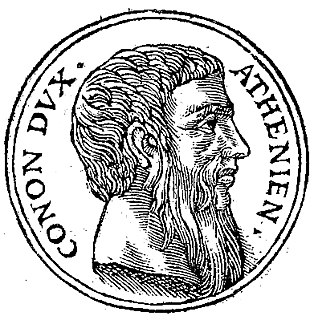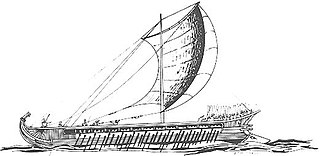
The Peloponnesian War was an ancient Greek war fought by the Delian League led by Athens against the Peloponnesian League led by Sparta. Historians have traditionally divided the war into three phases. In the first phase, the Archidamian War, Sparta launched repeated invasions of Attica, while Athens took advantage of its naval supremacy to raid the coast of the Peloponnese and attempt to suppress signs of unrest in its empire. This period of the war was concluded in 421 BC, with the signing of the Peace of Nicias. That treaty, however, was soon undermined by renewed fighting in the Peloponnese. In 415 BC, Athens dispatched a massive expeditionary force to attack Syracuse, Sicily; the attack failed disastrously, with the destruction of the entire force in 413 BC. This ushered in the final phase of the war, generally referred to either as the Decelean War, or the Ionian War. In this phase, Sparta, now receiving support from the Achaemenid Empire, supported rebellions in Athens's subject states in the Aegean Sea and Ionia, undermining Athens's empire, and, eventually, depriving the city of naval supremacy. The destruction of Athens's fleet in the Battle of Aegospotami effectively ended the war, and Athens surrendered in the following year. Corinth and Thebes demanded that Athens should be destroyed and all its citizens should be enslaved, but Sparta refused.

The 5th century BC started the first day of 500 BC and ended the last day of 401 BC.
This article concerns the period 409 BC – 400 BC.
This article concerns the period 429 BC – 420 BC.
This decade witnessed the continuing decline of the Achaemenid Empire, fierce warfare amongst the Greek city-states during the Peloponnesian War, the ongoing Warring States period in Zhou dynasty China, and the closing years of the Olmec civilization in modern-day Mexico.
This article concerns the period 399 BC – 390 BC.
This article concerns the period 389 BC – 380 BC.

This is a timeline of ancient Greece from its emergence around 800 BC to its subjection to the Roman Empire in 146 BC.

Lysander was a Spartan admiral who commanded the Spartan fleet in the Hellespont which defeated the Athenians at Aegospotami in 405 BC. The following year, he was able to force the Athenians to capitulate, bringing the Peloponnesian War to an end. He then played a key role in Sparta's domination of Greece for the next decade until his death at the Battle of Haliartus.
Year 406 BC was a year of the pre-Julian Roman calendar. At the time, it was known as the Year of the Tribunate of Cossus, Ambustus, Cossus and Potitus. The denomination 406 BC for this year has been used since the early medieval period, when the Anno Domini calendar era became the prevalent method in Europe for naming years.

Conon was an Athenian general at the end of the Peloponnesian War, who led the Athenian naval forces when they were defeated by a Peloponnesian fleet in the crucial Battle of Aegospotami; later he contributed significantly to the restoration of Athens' political and military power.
Year 392 BC was a year of the pre-Julian Roman calendar. At the time, it was known as the Year of the Consulship of Poplicola and Capitolinus. The denomination 392 BC for this year has been used since the early medieval period, when the Anno Domini calendar era became the prevalent method in Europe for naming years.

Antalcidas, son of Leon, was an ancient Greek soldier, politician, and diplomat from Sparta.

The Battle of Aegospotami was a naval confrontation that took place in 405 BC and was the last major battle of the Peloponnesian War. In the battle, a Spartan fleet under Lysander destroyed the Athenian navy. This effectively ended the war, since Athens could not import grain or communicate with its empire without control of the sea.

The Corinthian War was an ancient Greek conflict lasting from 395 BC until 387 BC, pitting Sparta against a coalition of Thebes, Athens, Corinth and Argos, backed by the Achaemenid Empire. The immediate cause of the war was a local conflict in northwest Greece in which Thebes and Sparta intervened. The deeper cause was hostility towards Sparta, provoked by that city's "expansionism in Asia Minor, central and northern Greece and even the west". The Corinthian War followed the Peloponnesian War, in which Sparta had achieved hegemony over Athens and its allies.

Classical Greece was a period of around 200 years in Greek culture. This Classical period saw the annexation of much of modern-day Greece by the Persian Empire and its subsequent independence. Classical Greece had a powerful influence on the Roman Empire and on the foundations of Western civilization. Much of modern Western politics, artistic thought, scientific thought, theatre, literature and philosophy derives from this period of Greek history.
The Siege of Motya took place either in 398 or 397 BC in western Sicily. Dionysius, after securing peace with Carthage in 405 BC, had steadily increased his military power and had tightened his grip on Syracuse. He had fortified Syracuse against sieges and had created a large army of mercenaries and a large fleet, in addition to employing the catapult and quinqueremes for the first time in history. In 398 BC, he attacked and sacked the Phoenician city of Motya despite the Carthaginian relief effort led by Himilco. Carthage also lost most of her territorial gains secured in 405 BC after Dionysius declared war on Carthage in 398 BC.

The Battle of Catana took place in the summer of 397 BC. The Greek fleet under Leptines, the brother of Dionysius I of Syracuse, engaged the Carthaginian fleet under Mago near the city of Catana in Sicily. While the Greek army under Dionysius was present near the city of Catana during the battle, the Carthaginian army under Himilco was away in the interior of Sicily, making a detour around the erupting Mount Etna. The Carthaginian fleet crushed the Greek fleet in the battle, leading to the Carthaginian siege of Syracuse later in 397 BC.
The Siege of Segesta took place either in the summer of 398 BC or the spring of 397 BC. Dionysius the Elder, tyrant of Syracuse, after securing peace with Carthage in 405 BC, had steadily increased his military power and tightened his grip on Syracuse. He had fortified Syracuse against sieges and had created a large army of mercenaries and a large fleet, in addition to employing catapults and quinqueremes for the first time in history. In 398 BC he attacked and sacked the Phoenician city of Motya despite a Carthaginian relief effort led by Himilco II of Carthage. While Motya was under siege, Dionysius besieged and assaulted Segesta unsuccessfully. Following the sack of Motya, Segesta again came under siege by Greek forces, but the Elymian forces based in Segesta managed to inflict damage on the Greek camp in a daring night assault. When Himilco of Carthage arrived in Sicily with the Carthaginian army in the spring of 397 BC, Dionysius withdrew to Syracuse. The failure of Dionysius to secure a base in western Sicily meant the main events of the Second Sicilian war would be acted out mostly in eastern Sicily, sparing the Elymian and Phoenician cities the ravages of war until 368 BC.

Pausanias was the Agiad King of Sparta; the son of Pleistoanax. He ruled Sparta from 445 BC to 426 BC and again from 408 BC to 395 BC.










